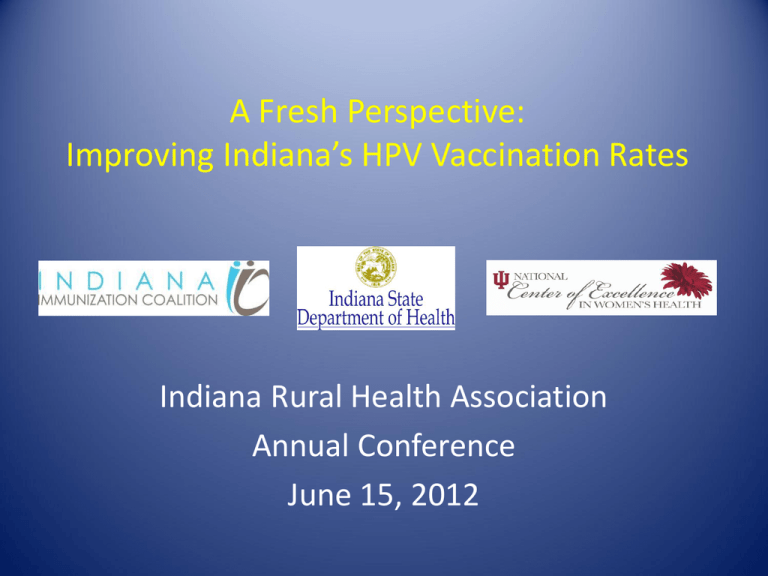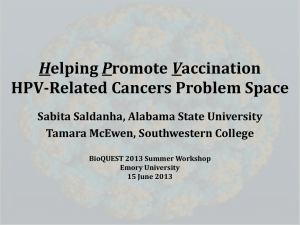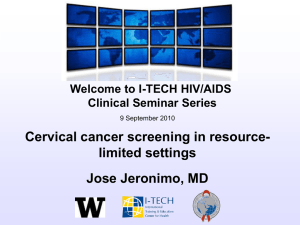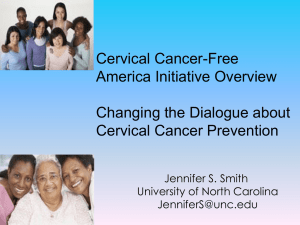A Fresh Perspective Improving Indiana`s HPV Vaccination Rates
advertisement

A Fresh Perspective: Improving Indiana’s HPV Vaccination Rates Indiana Rural Health Association Annual Conference June 15, 2012 Today’s Panel Moderator Deborah Stiffler, PhD, RN, CNM Associate Professor of Nursing, IU School of Nursing IRHA Board Member Indiana Immunization Coalition, Inc. Sarah Strawbridge, MSM, CHES, Executive Director Kristopher Kirby, BS, Operations Coordinator ISDH Breast & Cervical Cancer Program Erin Triplett, MPH, Director, Early Detection Programs/Chronic Disease Division IU National Center of Excellence in Women’s Health Tina Darling, BS, former Associate Director Lynn Baldwin, MSN, RN, WHNP-BC, former WOW Bus Coordinator Goal: Eradicate Cervical Cancer in Indiana • Overview/explanation of how improving Indiana’s HPV vaccination rates directly relates to cervical cancer prevention. • Efforts of IIC and ISDH BCCP • Efforts of IU CoE Goals for Clay County Project • To improve the health of all Indiana women, starting with a targeted cervical cancer education/awareness intervention pilot project for the women of Clay County. • To show that such an intervention in Clay County will increase the number of women utilizing preventive health care services, such as Pap smear screening, thereby improving their morbidity and mortality risk. • If successful, take the model used in Clay County and replicate it elsewhere in the state , for cervical cancer or other disease states, either in individual counties or by region, depending on the community in need. • By including health professions students in this outreach, increase the number of new graduates who decide to practice in rural Indiana. What is HPV? • HPV = Human Papillomavirus – Group of more than 150 related viruses – “papillomavirus” refers to the fact that certain types of HPV may cause papillomas, or warts, which are benign tumors • There are more than 100 types of HPV – More than 30 types can be transmitted through sexual contact HPV and Cervical Cancer • According to the National Cancer Institute, there are more than 6 million new genital HPV infections each year. HPV is the most commonly transmitted STI. • Almost all women will have an HPV infection at some point, but very few will develop cervical cancer • Virtually all cervical cancers are caused by HPV infections, with just two HPV types (16, 18) responsible for about 70% of all cases. Vaccination Guidelines • 47th • 3 doses over 6 months • Cervarix and Gardasil – Two brands of HPV vaccine – Best to receive all 3 doses from the same brand • Most effective when given before young adolescents and young adults become touchy feely or have sexual contact with his or her first partner Vaccination Guidelines cont. • • • • • Cervarix only for girls – 11 or 12 years of age - may be given starting at age 9 Gardasil for both males and females – 11 or 12 years of age - may be given starting at age 9 Catch-Up Schedule (for those who have not completed the 3-dose series) – Cervarix • Girls and women 13 through 26 years of age who did not get all 3 doses when they were younger – Gardasil • Females 13 through 26 years of age • Males 13 through 21 years of age • May be given to men 22 through 26 years of age who have not completed the 3-dose series 3 Dose Series* – 1st Dose - 11 or 12 years of age – 2nd Dose – 1 to 2 months after Dose 1 – 3rd Dose - 6 months after Dose 1 – *Additional (booster) doses are not recommended. HPV vaccine may be given at the same time as other vaccines Centers for Disease Control and Prevention, http://www.cdc.gov/vaccines/pubs/vis/default.htm Referrals • 3 Doses of the HPV vaccine AND regular screenings can prevent cervical cancer • No symptoms and can pass without even knowing it • Where to go? – – – – – Health Care Provider CHC/FQHC or Rural Health Clinic Local Health Department Little Red Door and Planned Parenthood Indiana Family Health Council, Inc. Economic Impact of HPV on Hoosiers • $3,400,000,000 is spent annually on diagnosis and treatment of HPV infection and its associated cervical diseases. • Women 20-29 years of age incur annual cost of $51, 863 per 1000 women. • Estimated lifetime total medical cost of HPV infection for men and women aged 15-24 is $2,900,000,000 (Source: Reducing the Health Burden of HPV Infection Through Vaccination, David Soper, Department of Obstetrics and Gynecology, Medical University of South Carolina, Charleston, SC 29425) Economic Impact of HPV on Hoosiers • Kristen Forbes’ Family Experience – Kristen’s Story – $380,000 in just one year of cervical cancer treatment • HPV is the second most expensive STI after HIV Contact Info ISDH Breast & Cervical Cancer Program Erin Triplett, MPH, Director Early Detection Programs/Chronic Disease Division etriplett@isdh.in.gov 317-233-7901 Indiana Immunization Coalition, Inc. Sarah Strawbridge, MSM, CHES, Executive Director director@vaccinateindiana.org 317-628-7116 Kristopher Kirby, BS, Operations Coordinator kkirby@vaccinateindiana.org 765-586-0249 Why Clay County? • In 2008, BRFSS showed only 57% of county’s estimated 15,595 women had received a Pap smear in the previous three years. Source: 2008 Behavioral Risk Factor Surveillance System sponsored by the Centers for Disease Control and Prevention. • Falls within the state’s Health Professions Shortage Area (HPSA). Source: Bureau of Health Professions, HHS, 2007. • Close proximity to regional health services and health professions students (IUSM, ISU) in Terre Haute. • St. Vincent health system presence in Brazil. Focus Groups and Key Informant Interviews • Engage in “friend-making” in the county – – – – – – James Buechler, MD, Lugar Center for Rural Health Peggy Davis, Purdue Extension Deb Plummer, YMCA of Clay County Mary Yelton, Clay County schools Clay City Center for Family Medicine Andrea Baysinger, St. Vincent Clay • Identified key gathering places for women • Identified county leaders for KII’s • Hired independent consultant to conduct Results • Major Health Problems? – Cancer (“Everyone seems to have cancer.”), fibromyalgia, heart disease, diabetes, osteoporosis, depression, obesity. • Barriers to Care & Screening? – Time, cost, access, denial and “family first.” “When in poverty, there is no prevention as people live day by day. Prevention is off their radar. They deal with other issues and don’t deal with what they don’t see. “ “Women put themselves last in relation to health. They take care of others first, it’s their natural instinct.” Results • Organization of Services? – Lack of specialists, especially Ob/Gyn (must leave county for specialty services) – Limited hours – “They [services] have limited hours and you have to go early or you may not get seen.” – Trust and Fear “…being afraid of finding out something bad.” “You can’t rely on providers. They don’t give all give feedback after tests. If it’s bad they tell you, but maybe not if it’s okay. They tend not to give specific values on the tests.” Results • Community and Policy Issues? – Low income = low expectations for health care – Lack of insurance “ [Employers] schedule workers so that they don’t work enough hours to qualify for health insurance.” – Limited social services to meet need – Illegal drug culture = isolation, interferes with accessing care – Smoking ban – tried without success “It’s removing personal rights. We need it, but there’s lots of resistance.” – Limited, if any, public transportation Conclusions 1) Even though cervical cancer not specifically identified as a problem by leaders and focus groups, we “followed the data” that said otherwise. 2) EDUCATE! 3) EDUCATE! 4) EDUCATE! “Need education. The community needs to be inundated with information through various avenues.” Quotes “There needs to be more education on it. . . some women just don’t know about those things.” “Education about the [program] needs to get out into the community. Mobile unit is good for this community, especially one from an outside entity – a positive.” “Women like to be part of a group that reaches out.” “It depends on how you are brought up. My mom did it, so I do too. “ Take our show on the road! • WOW Bus = Women’s Wellness on Wheels • Formerly the MOM Mobile/IU School of Nursing The WOW Bus! How the WOW Bus Works • Classroom with large screen TV & DVD player • 2 private assessment rooms for consultation • 2 private desks WoW Bus Education & Screening • Women would first watch a 10 minute DVD about Cervical Cancer and HPV • Private consultation with health professional student – Biometric screening including blood pressure, blood glucose, height, weight, BMI – Complete health assessment with student. Questions included: • • • • Demographics – age, BMI, health care coverage Health Prevention – current on screenings? Health Behaviors – diet, exercise, smoking, drug use Risk Factors – domestic violence, depression, sexual behaviors Education • DVD – Primarily used “Genital Warts and Cervical Cancer: The Woman’s Side” http://www.creativehealthcommunications.com – Also used web-based, interactive tutorial: “Pap Smear” by MedlinePlus http://www.nlm.nih.gov/medlineplus/tutorials/papsmear/htm/index.htm Education • Individualized education based on answers to assessment questions on iPads (data collected) • Gift bag included educational handouts: – – – – – – – – – Cervical Cancer & HPV Breast Cancer Smoking Cessation Diet & Exercise Diabetes Heart Health Mental Health Osteoporosis Colon Cancer Education – Centers for Disease Control and Prevention, http://www.cdc.gov – Central Indiana Affiliate – Susan G. Komen for the Cure, http://www.komenindy.org – Merck – produces the Gardasil vaccine – National Cancer Institute, http://www.cancer.gov – Office of Women’s Health, DHHS http://www.womenshealth.gov – U.S. Preventive Services Task Force Resources • Goal was to connect women to resources & services within their own community: – Breast & Cervical Cancer Program (BCCP) – Clay County Health Department – Crisis Pregnancy Center – Health care providers in Clay County – Planned Parenthood of Terre Haute – Weight Watchers Barriers • The screening took 20-30 minutes to complete • Childcare – limited space and personnel on the bus to watch children & keep them occupied • Up to date on health screenings or desired other screenings • Unsure of purpose of bus when driving or walking by Schedule the WoW Bus Tisha Reid, Associate Director IU National Center of Excellence in Women’s Health Phone: 317-948-3315 Email: iucoe@iupui.edu Results from iPad Surveys • A total of 101 women seen/surveyed • Ages 18-60+ (18 was minimum age to participate in screenings) What age range best represents your age? What was your BMI today? Averages • Average weight was 171.73 – Lowest 97.6 – Highest 290.4 • Average BMI was 28.9 – Lowest 16.9 – Highest 46.6 – BMI • • • • < 25 normal 25-29.9 overweight >30 obese >40 is morbidly obese Other Screenings • Random Blood Sugar – Average blood sugar was 98.76 ( normal is 70-140 mg/dl) • Lowest was 62 • Highest 184 • Blood Pressure – Average 127/76 • Highest systolic 163 • Highest diastolic 106 Depression Screen • Used the PHQ-9 screen – 5 women answered positively on our survey and were asked to complete the PHQ-9 • Scores 9, 12, 14, 20, 21 – – – – 5-9 minimal symptoms 10-14 minor depression, dysthymia, or mild major depression 15-19 major depression, moderately severe >20 major depression, severe Thinking about your mental health, such as stress, depression, and problems with emotions, during the past 30 days was there a time when your mental health was not good? How many days was your mental health not good? If you have been unable to see your healthcare provider, what was the reason? How long has it been since you have seen your healthcare provider? A mammogram is an x-ray of your breast. Have you ever had a mammogram? When was the last time that you had a mammogram? A Pap test is a test for cancer of the cervix. Have you ever had a Pap test? When was the last time that you had a Pap test? Strategies to Improve HPV Vaccination • As a provider, make a strong recommendation for the HPV vaccine – If a parent declines a vaccine, ask why and document in the chart. This can reinforce offering again at follow-up visits. – Make adolescent vaccination a priority • 2012 HEDIS measures – Adolescents 13 years of age should have received 1 dose of Tdap, 1 dose of meningococcal conjugate, and 3 doses of HPV (females only) by their 13th birthday • Create a SOP to check the vaccination status of your adolescent patients at every visit, even acute care visits • Encourage parents/guardians to schedule the next (two) dose(s) of HPV before leaving the office • Send reminder/recall notices to parents • Report vaccines that are administered within CHIRP (Indiana’s immunization registry) Strategies to Improve HPV Vaccination cont. • Work with local schools to promote adolescent immunization – Provide educational materials that can be disseminated to parents – Conducting ‘back-to-school’ vaccination clinics, all recommended vaccines should be offered, not just the vaccines that are required for school entry – Identify school-based heath centers in your area • Connect with public health system partners Thank You! Questions?






